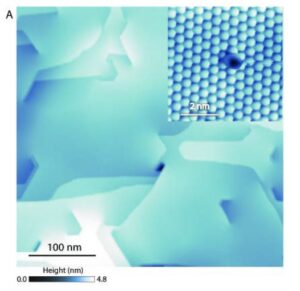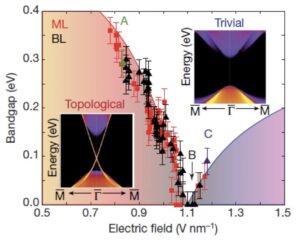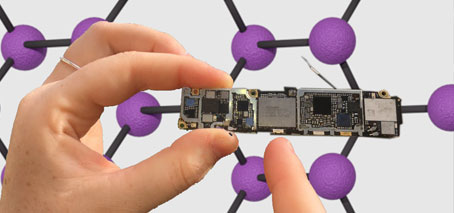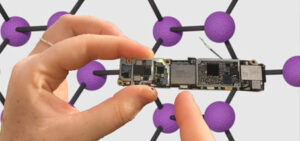A Meet FLEET innovation-and-industry event poster

Michael Fuhrer, FLEET Director, Monash University

Mark Edmonds, ARC Future Fellow, Monash University
The Challenge

Figure 1: Epitaxial thin film of topological Dirac semimetal Na3Bi on silicon (Image taken with scanning tunnelling microscope). Ref: M. T. Edmonds, et al., Science Advances 3 (12), eaao6661
Energy usage for computing has been recognized by the Breakthrough Energy Fund as one of the world’s major problems needing future solutions. Carbon dioxide (CO2) emissions are linked to climate change. While energy production and chemical industries are the major CO2 producers, large data centres and computing technology, in general, are also contributing to CO2 emissions and energy needs; this is a fast-growing problem.
The Solution
Our solution comprises a method of forming a topological Dirac semimetal layer on a substrate. The topological transistor is switched from conventional insulator to topological insulator via an electric field, with a tuneable bandgap. The new system aims for a ten-fold improvement in energy efficiency.
Key Benefits
- Novel IP on 2D materials
- Demonstrated Bandgap and Switching
Development Stage
- Technology Concept completed
- Seeking strategic partners
Brief Description & Differentiation

Figure 2: Tuning bandgap of ultrathin Na3Bi with electric field. Ref: J. L. Collins, et al., Nature 564 (7736), 390
The aim of this system is a 10x improvement in energy efficiency according to Moore’s Law. We envision a topological transistor in which an electric field from gate electrodes switches a material from a conventional insulator to a topological insulator. In the topological insulator, current will be carried by ballistic 1D edge modes.
We have developed a method of forming a topological Dirac semimetal layer on a substrate (Fig. 1). Using this 2D material, we have developed an electric field-effect structure that can be used to alter the charge carrier density and band gap in a topological Dirac semimetal film. In an ultrathin topological Dirac semi-metal, we can tune the bandgap by over 400 meV, from topological insulator to conventional insulator, realising a platform suitable for a topological transistor. (Fig. 2).
Intellectual Property
National filings on PCT/AU2017/050399 (USA, China and Australia)
Key Publications
- Collins, J. L., et al, Electric-Field-Tuned Topological Phase Transition in Ultrathin Na3Bi. Nature 2018, 564 (7736), 390–394 (DOI 10.1038/s41586-018-0788-5)
- Edmonds, M. T., et al, Spatial Charge Inhomogeneity and Defect States in Topological Dirac Semimetal Thin Films of Na3Bi. Sci. Adv. 2017, 3 (12) (DOI 10.1126/sciadv.aao6661)
- Nadeem, M., et al, Overcoming Boltzmann’s Tyranny in a Transistor via the Topological Quantum Field Effect Nano Letters 2021, 21, 3155 (DOI 10.1021/acs.nanolett.1c00378)
- Fuhrer, M.S., et al.,Proposal for a Negative Capacitance Topological Quantum Field-Effect Transistor IEDM Volume 2021-December, Pages 38.2.1 – 38.2.4. 2021 IEEE International Electron Devices Meeting (IEDM 2021)
More information
- Contact Prof Michael Fuhrer, Monash University Michael.Fuhrer@monash.edu
- Contact Dr Mark Edmonds, Monash University Mark.Edmonds@monash.edu






